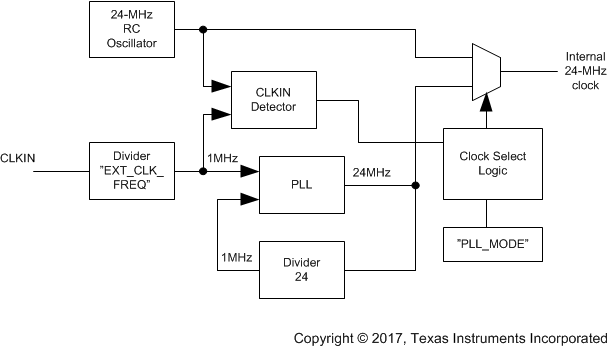SNVSBA3 December 2020 LP875761-Q1
PRODUCTION DATA
- 1 Features
- 2 Applications
- 3 Description
- 4 Revision History
- 5 Pin Configuration and Functions
- 6 Specifications
-
7 Detailed Description
- 7.1 Overview
- 7.2 Functional Block Diagram
- 7.3
Feature Descriptions
- 7.3.1 Multi-Phase DC/DC Converters
- 7.3.2 Sync Clock Functionality
- 7.3.3 Power-Up
- 7.3.4 Regulator Control
- 7.3.5 Enable and Disable Sequences
- 7.3.6 Device Reset Scenarios
- 7.3.7 Diagnosis and Protection Features
- 7.3.8 GPIO Signal Operation
- 7.3.9 Digital Signal Filtering
- 7.4 Device Functional Modes
- 7.5 Programming
- 7.6
Register Maps
- 7.6.1
Register Descriptions
- 53
- 7.6.1.1 DEV_REV
- 7.6.1.2 OTP_REV
- 7.6.1.3 BUCK0_CTRL1
- 7.6.1.4 BUCK0_CTRL2
- 7.6.1.5 BUCK1_CTRL2
- 7.6.1.6 BUCK2_CTRL2
- 7.6.1.7 BUCK3_CTRL2
- 7.6.1.8 BUCK0_DELAY
- 7.6.1.9 GPIO2_DELAY
- 7.6.1.10 GPIO3_DELAY
- 7.6.1.11 RESET
- 7.6.1.12 CONFIG
- 7.6.1.13 INT_TOP1
- 7.6.1.14 INT_TOP2
- 7.6.1.15 INT_BUCK_0_1
- 7.6.1.16 INT_BUCK_2_3
- 7.6.1.17 TOP_STAT
- 7.6.1.18 BUCK_0_1_STAT
- 7.6.1.19 BUCK_2_3_STAT
- 7.6.1.20 TOP_MASK1
- 7.6.1.21 TOP_MASK2
- 7.6.1.22 BUCK_0_1_MASK
- 7.6.1.23 BUCK_2_3_MASK
- 7.6.1.24 SEL_I_LOAD
- 7.6.1.25 I_LOAD_2
- 7.6.1.26 I_LOAD_1
- 7.6.1.27 PGOOD_CTRL1
- 7.6.1.28 PGOOD_CTRL2
- 7.6.1.29 PGOOD_FLT
- 7.6.1.30 PLL_CTRL
- 7.6.1.31 PIN_FUNCTION
- 7.6.1.32 GPIO_CONFIG
- 7.6.1.33 GPIO_IN
- 7.6.1.34 GPIO_OUT
- 7.6.1
Register Descriptions
- 8 Application and Implementation
- 9 Power Supply Recommendations
- 10Layout
- 11Device and Documentation Support
- 12Mechanical, Packaging, and Orderable Information
Package Options
Refer to the PDF data sheet for device specific package drawings
Mechanical Data (Package|Pins)
- RNF|26
Thermal pad, mechanical data (Package|Pins)
Orderable Information
7.3.2 Sync Clock Functionality
The LP875761-Q1 device contains a CLKIN input to synchronize switching clock of the buck regulator with the external clock. The block diagram of the clocking and PLL module is shown in Figure 7-4. Depending on the PLL_MODE[1:0] bits (in PLL_CTRL register) and the external clock availability, the external clock is selected and interrupt is generated as shown in Table 7-2. The interrupt can be masked with SYNC_CLK_MASK bit in TOP_MASK1 register. The nominal frequency of the external input clock is set by EXT_CLK_FREQ[4:0] bits (in PLL_CTRL register) and it can be from 1 MHz to 24 MHz with 1-MHz steps. The external clock must be inside accuracy limits (–30%/+10%) for valid clock detection.
The NO_SYNC_CLK interrupt (in INT_TOP1 register) is also generated in cases the external clock is expected but it is not available. These cases are start-up (read OTP-to-STANDBY transition) when PLL_MODE[1:0] = 01 and regulator enable (STANDBY-to-ACTIVE transition) when PLL_MODE[1:0] = 10.
 Figure 7-4 Clock and
PLL Module
Figure 7-4 Clock and
PLL Module| DEVICE OPERATION MODE | PLL_MODE[1:0] | PLL AND CLOCK DETECTOR STATE | INTERRUPT FOR EXTERNAL CLOCK | CLOCK |
|---|---|---|---|---|
| STANDBY | 0h | Disabled | No | Internal RC |
| ACTIVE | 0h | Disabled | No | Internal RC |
| STANDBY | 1h | Enabled | When external clock appears or disappears | Automatic change to external clock when available |
| ACTIVE | 1h | Enabled | When external clock appears or disappears | Automatic change to external clock when available |
| STANDBY | 2h | Disabled | No | Internal RC |
| ACTIVE | 2h | Enabled | When external clock appears or disappears | Automatic change to external clock when available |
| STANDBY | 3h | Reserved | ||
| ACTIVE | 3h | Reserved | ||